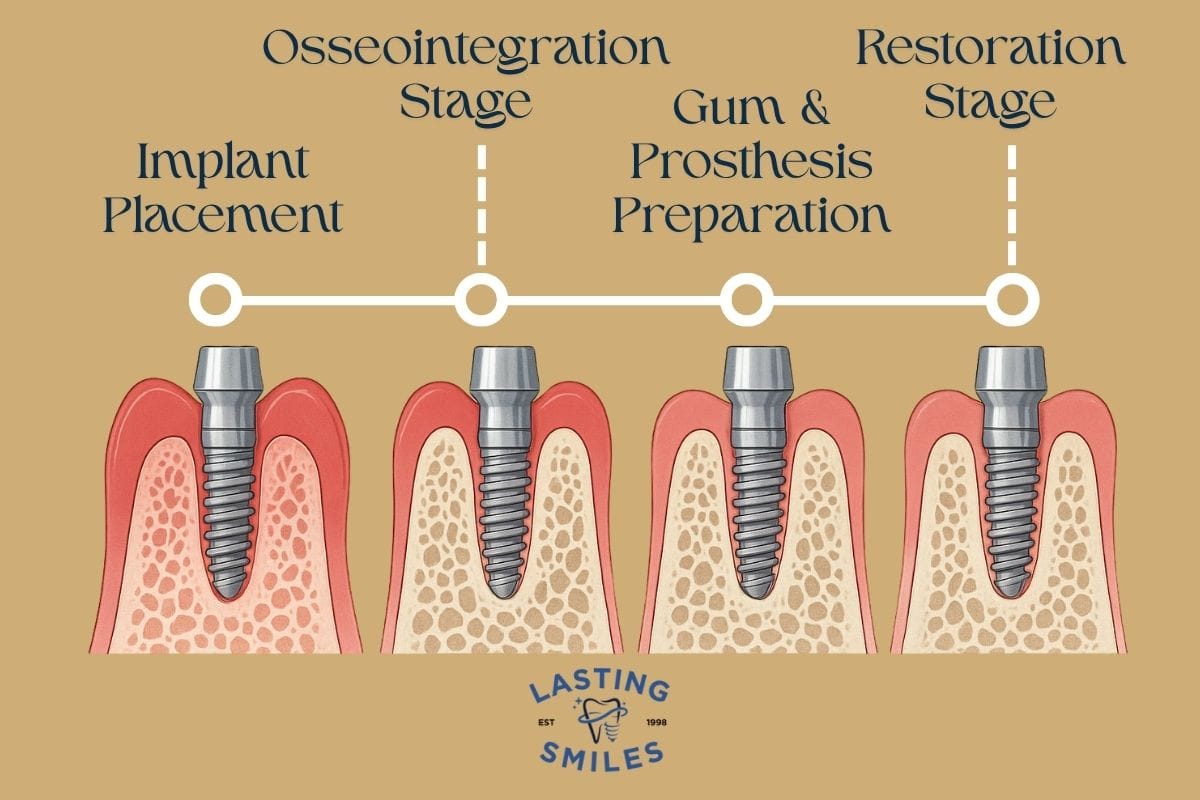
If you’re considering dental implants—or if you’ve recently had one placed—you may be wondering: What happens now? How long will I be in recovery? And when can I eat normally again? This in‑depth guide walks you through the entire healing journey of a dental implant, from surgery to restoration, and includes practical tips for care, timelines, and links to relevant resources on our website.
Why Understanding the Healing Process Matters
Successful dental implant treatment isn’t just about placing the post—it’s about allowing your body time to heal, integrate the implant into your jawbone (osseointegration), and then restore a crown, bridge, or prosthesis with long‑term stability.
As the post “Dental Implants: Answers to Common Questions About Downsides, Longevity, Pain, Insurance, and Treatment Timeline” from Lasting Smiles explains, one of the key “downsides” (or rather realities) of implants is that “there is a healing period after implant placement”.
Understanding the steps ahead will help you plan appropriately, manage expectations, and support healing to get the best outcome.
The Four Major Healing Stages of Dental Implants
Most implant journeys can be broadly divided into four key phases—and knowing what to expect in each can ease anxiety and improve outcomes.
1. Surgical Stage (Implant Placement)
This is the initial event: the implant post (typically titanium or zirconia) is placed into your jawbone. It may be done after extraction, or if your tooth was already missing, directly.
What happens:
- Your gums are opened, the implant placed into the bone, possibly with a graft or sinus lift if needed.
- Sutures may be placed; you’ll go home with post‑operative instructions.
Key care tips:
- Rest, keep your head elevated, apply a cold pack for swelling.
- Avoid heavy lifting, strenuous exercise, and don’t disturb the surgical area with your tongue or fingers.
- A soft‑food diet is strongly recommended initially.
- For dietary guidance, see our post “When Can You Eat Normally After Dental Implant Surgery?”
Typical duration: 1–2 weeks of initial healing, while soft tissue recovers and you adjust to life post‑surgery.
2. Osseointegration Healing Stage
This is the critical period where the implant integrates with your bone—the process called osseointegration. Without good integration, the implant cannot become stable.
What happens:
- The jawbone begins to grow and fuse around the implant surface.
- You may still be in a transitional or temporary prosthesis phase.
- You may need to avoid biting directly on the implant site for a period.
Key care tips:
- Maintain excellent oral hygiene—keep the area clean and avoid infection.
- Avoid smoking, as it impairs bone healing.
- Follow your dentist’s guidelines for when you can gradually resume certain foods or activities.
Typical duration: about 3–6 months, depending on factors like bone quality, whether a graft was used, your health status, and location of the implant (upper jaw vs. lower jaw). Some guides cite up to 12 months in complex cases.
3. Post‑Implant Healing Stage (Gum & Prosthesis Preparation)
This phase bridges the gap between integration and restoration. The soft tissue around the implant matures, and your provider may place the abutment (connector) and prepare the final prosthetic.
What happens:
- Your gums are shaped around the implant/abutment interface.
- You will have impressions or scans done for your final crown/bridge.
- A temporary prosthetic may be in place while the final one is crafted.
Key care tips:
- Continue gentle cleaning around the site.
- Avoid heavy chewing on the implant until your provider gives the go‑ahead.
- Attend follow‑up visits to monitor healing and tissue health.
Typical duration: a few weeks to a couple of months depending on your prosthetic timeline.
4. Restoration Stage (Final Crown, Bridge or Prosthesis)
This is the exciting final phase—your permanent tooth/teeth are attached and you return to full function.
What happens:
- Final restoration is secured (cemented or screwed) onto the abutment.
- Your provider will calibrate your bite, check alignment, and make final adjustments.
- You transition to long‑term maintenance.
Key care tips:
- Treat your implant restorations essentially like natural teeth—daily brushing, flossing, regular cleanings.
- Avoid using your teeth as tools (opening bottles, biting ice, etc.).
- If you grind at night, a night guard is strongly recommended.
Once complete, you’ll enjoy the full benefits of your implant—function, aesthetics, and confidence.
Day‑by‑Day Example: What to Expect Week 1 and Beyond
Here’s a more detailed breakdown of what you might expect shortly after surgery. Every patient is different, but this gives a realistic timeline.
- Day 1: Rest, soft diet, avoid straws, apply cold packs for 20 minutes on/20 off.
- Day 2: Swelling may peak; use warm salt water rinses, avoid brushing the site directly.
- Day 3: Bruising may appear; continue soft foods; resume gentle activity but avoid heavy exercise.
- Day 4–5: Swelling receding; perhaps start very light back‑chewing (if approved); continue gentle hygiene.
- Day 6–7: You may feel significantly better; follow‑up check with dentist.
- Weeks 2–4: Most soft‑tissue healing complete; you may resume more normal diet gradually.
- Months 3–6: Your bone is integrating; final restoration may be planned during this interval.
As we explain in our blog on diet after implant surgery: “most patients can expect to eat normally within two to four weeks after their dental implant surgery” when healing proceeds well.
Factors That Affect Healing Time & Success
Your individual healing will depend on multiple factors—including:
- Bone quality and location (lower jaw often heals faster than upper).
- Whether extraction or bone grafting was needed beforehand.
- Overall health, nutrition, smoking status, and medications.
- Consistency of follow‑up care and oral hygiene.
- Whether the implant was immediately loaded (same‑day tooth) or in a delayed protocol.
Read more about rehabilitation timelines and full‑arch options on our Dental Implants page.
Tips for Smooth Recovery & Long‑Term Success
Here are best‑practice care tips to support healing and longevity:
- Maintain hygiene: Brush twice daily using a soft toothbrush; floss and use interdental brushes or water‑flosser to clean around the implant site.
- Diet: Start soft, then reintroduce firmer foods gradually. For detailed guidelines, see our post on when you can resume a normal diet.
- Avoid smoking & excessive alcohol: These impair healing and raise risk of complications.
- Attend regular dental checkups: We recommend professional cleanings at least twice a year; implants are not immune to gum‑related problems (see our article on peri‑implantitis).
- Protect against grinding: If you grind your teeth at night, a night guard can safeguard your implant and prosthetic.
- Follow your dentist’s instructions: Stay on top of medication, avoid straws or spitting in the early hours, keep your follow‑up appointments.
Common FAQs About Healing
How long until I can eat normally?
Many patients return to a near‑normal diet within 2 to 4 weeks, provided healing goes smoothly.
Is the process painful?
Discomfort is typically mild—most patients describe swelling and soreness for 1–3 days, easily managed with over‑the‑counter medication. Detailed insight is in our FAQ guide.
What if I need a bone graft?
Bone grafting may extend your healing timeline (often 3–6 months before the implant is placed) but it enables a stronger foundation for long‑term success.
Why is healing longer for full‑arch or “all‑on‑4” cases?
Full‑arch reconstructions often involve more implants, more surgical sites, and sometimes grafting—thus they may require more healing time. See our guide on the full‑arch process.
Can I be “tooth‑free” during healing?
Yes. Modern implant protocols—including same‑day teeth or temporary prosthetics—ensure you aren’t left without a functional smile while healing continues.
How do I know if my dental implant is healing properly?
Signs of proper healing include reduced swelling after the first few days, minimal pain, no signs of infection (pus, bad taste, excessive redness), and a gradual return to normal function. If you notice persistent pain, mobility in the implant, or swelling after two weeks, contact us immediately. Visit our FAQ page for more healing-related concerns.
Can I speed up the dental implant healing process?
While you can’t “rush” bone healing, you can support and optimize it. Follow your surgeon’s post-op instructions closely, avoid smoking, maintain good nutrition, stay hydrated, and use any prescribed antibiotics or rinses. Adhering to these habits gives your implant the best chance to integrate successfully.
What foods should I avoid during dental implant recovery?
During the first week, stick to soft foods like mashed potatoes, yogurt, eggs, and soups. Avoid crunchy, sticky, spicy, or hard foods. As healing progresses, you can slowly reintroduce firmer foods—ask your dentist for guidance. For tips, read our article on when you can eat normally again after implant surgery.
Are dental implants more painful than tooth extractions?
Not usually. Most patients report less discomfort after an implant than they expected—often less than a tooth extraction. Sedation and local anesthesia keep you comfortable during the procedure, and pain is typically manageable with over-the-counter medication. Learn more about comfort and sedation options on our sedation dentistry.
What happens if my implant doesn’t heal properly?
If osseointegration fails (which is rare), the implant may become loose or infected. In such cases, the implant is removed, the area allowed to heal, and a new implant may be placed after proper recovery. Our team at Lasting Smiles monitors you throughout the process to ensure early intervention if anything seems off.
Do all dental implants require 3–6 months of healing?
Not necessarily. Some patients may qualify for New Teeth in One Day using immediate-load implants. However, traditional healing timelines still apply for most patients, particularly if bone grafts or multiple implants are involved. Our dentists will review your CT scan and health profile to recommend the ideal timeline for you.
Conclusion: Your Journey to a Lasting Smile
Healing after a dental implant is not a passive waiting game—it’s an active partnership between your body, your provider, and your daily care routine. From the surgery to osseointegration to final restoration, each stage matters for long‑term success.
At Lasting Smiles, we guide patients from the first consultation through every healing stage, leveraging advanced 3‑D imaging, proven protocols, and personalized support. Whether you’re in Irvine, Pasadena, or Las Vegas, our team is committed to getting you back to full function—eating, laughing, and speaking with confidence.
Remember: patience during healing pays off in durability, comfort, and the freedom that a well‑integrated implant provides. If you’d like to learn whether you’re a good candidate or begin your implant journey, book your consultation with Lasting Smiles today.
Recent Articles
Denture Stabilization: A Life-Changing Solution for Lasting Comfort and Confidence
For millions of Americans who wear dentures, discomfort, slippage, and messy adhesives are a daily frustration. At Lasting Smiles, we offer a powerful...
Understanding the Dental Implant Healing Stages: What to Expect & How to Care
If you’re considering dental implants—or if you’ve recently had one placed—you may be wondering: What happens now? How long will I be in...
Hybridge Dental Implants: A Permanent Full-Arch Solution for Lasting Smiles
Missing teeth, failing crowns, and frustrating dentures can seriously impact your confidence, comfort, and overall quality of life. At Lasting Smiles, we’re proud...


